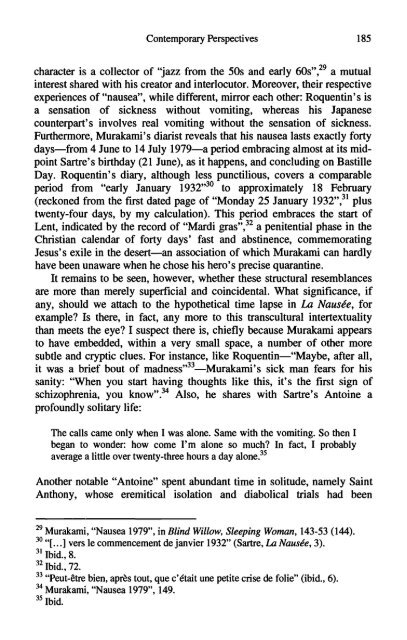Sartre's second century
Sartre's second century
Sartre's second century
Create successful ePaper yourself
Turn your PDF publications into a flip-book with our unique Google optimized e-Paper software.
Contemporary Perspectives 185<br />
character is a collector of "jazz from the 50s and early 60s", a mutual<br />
interest shared with his creator and interlocutor. Moreover, their respective<br />
experiences of "nausea", while different, mirror each other: Roquentin's is<br />
a sensation of sickness without vomiting, whereas his Japanese<br />
counterpart's involves real vomiting without the sensation of sickness.<br />
Furthermore, Murakami's diarist reveals that his nausea lasts exactly forty<br />
days—from 4 June to 14 July 1979—a period embracing almost at its midpoint<br />
<strong>Sartre's</strong> birthday (21 June), as it happens, and concluding on Bastille<br />
Day. Roquentin's diary, although less punctilious, covers a comparable<br />
period from "early January 1932" 30 to approximately 18 February<br />
(reckoned from the first dated page of "Monday 25 January 1932", 31 plus<br />
twenty-four days, by my calculation). This period embraces the start of<br />
Lent, indicated by the record of "Mardi gras", 32 a penitential phase in the<br />
Christian calendar of forty days' fast and abstinence, commemorating<br />
Jesus's exile in the desert—an association of which Murakami can hardly<br />
have been unaware when he chose his hero's precise quarantine.<br />
It remains to be seen, however, whether these structural resemblances<br />
are more than merely superficial and coincidental. What significance, if<br />
any, should we attach to the hypothetical time lapse in La Nausee, for<br />
example? Is there, in fact, any more to this transcultural intertextuality<br />
than meets the eye? I suspect there is, chiefly because Murakami appears<br />
to have embedded, within a very small space, a number of other more<br />
subtle and cryptic clues. For instance, like Roquentin—"Maybe, after all,<br />
it was a brief bout of madness" 33 —Murakami's sick man fears for his<br />
sanity: "When you start having thoughts like this, it's the first sign of<br />
schizophrenia, you know". 34 Also, he shares with <strong>Sartre's</strong> Antoine a<br />
profoundly solitary life:<br />
The calls came only when I was alone. Same with the vomiting. So then I<br />
began to wonder: how come I'm alone so much? In fact, I probably<br />
average a little over twenty-three hours a day alone. 35<br />
Another notable "Antoine" spent abundant time in solitude, namely Saint<br />
Anthony, whose eremitical isolation and diabolical trials had been<br />
29<br />
Murakami, "Nausea 1979", in Blind Willow, Sleeping Woman, 143-53 (144).<br />
30<br />
"[...] vers le commencement de Janvier 1932" (Sartre, La Nausee, 3).<br />
31<br />
Ibid., 8.<br />
32<br />
Ibid., 72.<br />
33<br />
"Peut-etre bien, apr£s tout, que c'dtait une petite crise de folie" (ibid., 6).<br />
34<br />
Murakami, "Nausea 1979", 149.
















